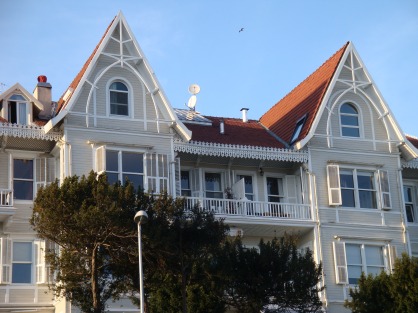“Dry Fountain”
Midway between Ortaköy and Arnavutöy, Kuruçeşme is another trendy Bosphorus suburb, albeit a strangely unfocused one. It’s at this point that the Bosphorus starts to open out and the view across to the Kuleli Military High School at Vaniköy on the Asian shore is enchanting.
Coming from Ortaköy you will pass a string of nightclubs and then a cluster of restaurants built in completely haphazard fashion. Beyond them there is a small waterside park looking over Suada, an islet which, in 2024, looked as if it might be about to regain some of the cachet it had as a glitzy place to dine out before it became so overbuilt that all the structures on it were demolished.
Inland along Kırbaç Sokak several churches bear witness to the area’s more cosmopolitan past. Then the road bends round to Arnavutköy with its wonderful, distinctive wooden yalıs (waterside mansions).
The İstanbul Stylites Not so long ago Kuruçeşme was best known as a place where sand and coal were stored. But long before that it made itself the site of a curious historical footnote when two stylite saints, St Simeon the Stylite (sitting 433-60) and St Daniel the Stylite (sitting 460-93), perched on top of pillars overlooking the Bosphorus in an extraordinary act of religious dedication.
 Surp HaçAround Kuruçeşme
Surp HaçAround Kuruçeşme
If you head inland along Kırbaç Sokak you will pass on the left the large Armenian Church of Surp Haç (Holy Cross), designed in 1881 by Garabet Balyan and standing in a walled enclosure lined with old gravestones. The church is usually open to visitors.
A the top end of the street steps lead up to the small, icon-filled Greek Orthodox Church of Hagios Demetrios, dating back to 1798. The main reason to come here is to explore the tunnel at the back of the church which leads to an ayazma (sacred spring) that flows down into it. Over time calcium from the dripping water has coated the walls in cave-like rock formations that have since been covered in graffiti. It’s an unexpectedly atmospheric treat.
 Hagios DemetriosReturning to the coast road, you can gaze across at Suada (Water Island, Galatasaray Adası). In 1880 Sultan Abdülhamid II gave it to the architect, Sarkis Balyan, as a thank-you for his many designs for the city. Sadly his yalı was later demolished and the island developed until it became almost invisible beneath the weight of building.
Hagios DemetriosReturning to the coast road, you can gaze across at Suada (Water Island, Galatasaray Adası). In 1880 Sultan Abdülhamid II gave it to the architect, Sarkis Balyan, as a thank-you for his many designs for the city. Sadly his yalı was later demolished and the island developed until it became almost invisible beneath the weight of building.
As you walk towards Arnavutköy you will see the lovely Kırmızı Yalı (Red Yalı) still painted the rusty-red colour that used to be called Ottoman rose. Built for Sultan Mahmud II’s gardener in the 1830s, it eventually became home to the prominent female archaeologist Halet Çambel who eventually donated it to Boğazıcı (Bosphorus) University. Sadly, the paintwork is steadily peeling off and the yali seems unused.
Inland from Kuruçeşme is Robert College, a curiously lovely but alien campus that was built in 1871 as the American College for Girls. In 1971 it amalgamated with the boys college in Bebek to form a co-ed establishment that is still operating today. Unfortunately in the 2020s the university became embroiled in argument over its management, a quarrel that was still ongoing in 2024.
Finally, as you walk into Arnavutköy you may see, peeping up above the wall, the small wooden dome that tops off the Greek Orthodox Church of Ioannes Prodoromos (John the Baptist).
 Ali Vali EviSleeping
Ali Vali EviSleeping
Les Ottomans. Tel: 0212-359 1500
Transport info
Most of the buses running along the Bosphorus from Kabataş and Beşiktaş pass through Kuruçeşme.
Nearby areas


